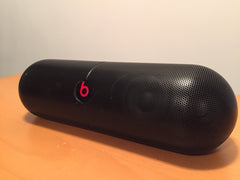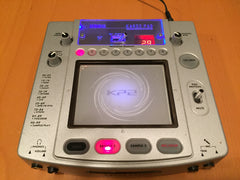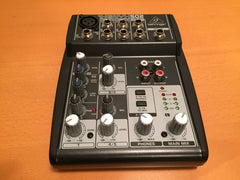The Essentials
As much as the jamstik has changed how people learn how to play guitar or record their ideas in GarageBand or other recording apps, it’s also a great controller for live performances. As someone who has spent years in guitar-based live bands with no keyboard players, trust me when I say it’s hard to cover three hours of familiar material for an audience in one night without running into a tune that needs a signature keyboard part. You know how it goes - you need a synth sound to do the first solo in The Cars' “Just What I Needed” or you’d like to have a xylophone for The Violent Femmes' “Gone Daddy Gone.” Using a MIDI controller like the jamstik enables you to get around having to worry about click tracks, background tracks, hurting the drummer’s feelings (“look, it’s not because you’re a bad timekeeper, but we’ve gotta follow this click for these tunes,”) or a sound guy who stepped away from the console to apologize to the club owner for being forty-five minutes late for load-in with the “track playback” muted.
I’ve also found the jamstik to be a real spark of variety when doing acoustic sets with a friend. I don’t mind doing three 45-minute sets of acoustic guitar with a buddy for some extra coin, but about halfway into the second set I’m getting pretty bored with the whole “unplugged” vibe. I use the jamstik in acoustic sets like cilantro on a taco - just a little bit of it here and there can really add some “wow” factor. It’s a two-man show. I can put down my guitar and pick up the jamstik for a tune and bring in the GarageBand acoustic guitar with a synth pad from Animoog and/or a forward-backward toy piano in e-l-s-a. (Did I just give away my favorite secret sauce ingredient? Yep.) It’s fun watching everyone in the room go through a huge mindscrew trying to sort out what is happening before their eyes. No joke, it works every time.
But in order for this to really work, you have to have your rig sorted out in advance. If you just show up with your jamstik and iPad or Mac and think the sound engineer or your bandmates will have the extras you’re going to need, you’ll be outta’ luck. I’m the kind of guy who likes to prepare for the worst, so I have a jamstik rig ready to go for just about every situation I can imagine. It’s not complicated or hard to find stuff. You don’t need the whole kit unless you’re a paranoid freak like me.
First things first, IK Multimedia’s iKlip 2 is an essential. The Klip 2 holds an iPad 2 up to the iPad Airs with the adapter kit and screw-clamps to a mic stand. It’s super handy and keeps your iPad neatly in reach of your performance. I tried to do a couple of shows without one of these, and if you’ve got to change some settings often you’ll be looking like you’re stopping the show to check Snapchat between tunes.


This may seem super silly, but if you’re using the headphone output of the iPad in live use you’ll want to have a Belkin Rockstar, some kind of headphone cable extender, and a ⅛-inch TRS male to two RCA male cable ends with two RCA female to ¼-inch male adapters. No lie, I have three of each. Why? I keep duplicates in separate locations for different needs (see: “paranoid freak” comment from above), but it never fails. I need to split the signal somewhere and the Rockstar has lots of normaled connections. I once had a last-minute live video interview and the iPad’s output couldn’t be monitored back to me because there were no monitors, so I used the extension to put the Rockstar out of the camera’s line of sight and patched in the next piece of this kit for an impromptu monitor.


I use a BeatsPillXL for a number of monitoring applications. It’s compact and fits in a backpack or carry-on. It makes a lot of sound, it’s rechargeable battery-powered, and it’s got a decent low end thump. It works good as a small stage monitor for the iPad in the acoustic scenario I mentioned above. Plus, even on a live stage with a drummer pounding away, I can position it to hear what I need to out of it. That’s not to say that there aren’t a lot of solutions for this - the IK Multimedia iLoud has decent reviews. I know the Marshall Stanmore throws down. I just like the BeatsPillXL’s design for what I need it to do. One caveat though - if you think you’re going to stream Bluetooth audio from your iPad to anything without incurring performance-killing latency, bring a ⅛-inch TRS male-to-male cable. You’ll use it in about 20 seconds of attempting to use Bluetooth for audio.

The Luxuries
The following items are more candy and overkill, but once I started using them it was hard to break their addictive powers.
I carry a Korg KAOSS Pad 2 for live wacky effects (just gave away another secret sauce ingredient!) While iOS has lots of great apps with effects and sonic candy, I found I needed a standalone thing for single-use situations. I assign the presets for effects I can trigger at the ends of songs or during breakdowns to do interesting sonic tricks. It’s not something you should use all of the time (“sir, put your hands up and step away from the KAOSS Pad”), but when tastefully added to your arsenal of sound you’ll appear to be a wizard of neat noises. I bought mine on eBay for cheap. The newer ones have lots of options, but I don’t have the deepest of pockets so the two work just fine for my needs.

I also keep a Behringer Xenyx 502 handy. It’s small (I can keep it in a guitar case or pedal bag), and it gets the job done without adding noise to the signal. Inevitably at some point (like the Rockstar splitter above), you'll need to have another set of inputs, hotter outputs, separate headphone out, whatever… When you don’t have one, you’ll run into a situation where you wish you did. Any small mixer will do; these just happen to be cheap and available at every Guitar Center I go to.

Every venue I get into has Direct Input (DI) boxes. Most of the DI boxes available are of decent quality so I don’t bother carrying DI’s. Besides, all of my bass-playing friends have permanently “borrowed” my DI boxes so I don’t feel like lending more of them out.
That pretty much covers every “live play” scenario I’ve brought the jamstik into. If you’ve got some go-to pieces, please let us in on your rig in the comment section below. You might have something that we’ve missed!
Christopher Heille is the Music Product Specialist with Zivix LLC - the company behind the jamstik and PUC. Chris is a champion for musicians everywhere and encourages anyone with any type of musical ability to get connected and start making music. His earliest "bandmates" were Tascam PortaStudios and Ensoniq SQ80's, supplementing the missing bass and keyboard players for his original live shows as a teenager. As a guitar player who wasn't intimidated by keyboards or MIDI, he was an early adopter to recording on DAWs and has been involved in various capacities (musician, vocalist, programmer, songwriter, engineer, producer, studio owner) on more projects than he can remember. Chris believes the future of the music business is not in New York City, Los Angeles or Nashville, but in the network of shared ideas and creativity. This belief continues to drive his efforts at Minneapolis-based Zivix, LLC. Find him on Twitter @drewchowen.



Share:
How You Can Apply an “Abbey Road” Philosophy to Your Music
What Is MIDI and How Does the Jamstik Use it?
1 comment
Will work with just a Mac?